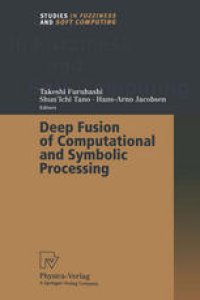
Ebook: Deep Fusion of Computational and Symbolic Processing
Author: Ron Sun Todd Peterson (auth.) Dr. Takeshi Furuhashi Dr. Shun’Ichi Tano Dr. Hans-Arno Jacobsen (eds.)
- Tags: Programming Techniques, Artificial Intelligence (incl. Robotics)
- Series: Studies in Fuzziness and Soft Computing 59
- Year: 2001
- Publisher: Physica-Verlag Heidelberg
- Edition: 1
- Language: English
- pdf
Symbolic processing has limitations highlighted by the symbol grounding problem. Computational processing methods, like fuzzy logic, neural networks, and statistical methods have appeared to overcome these problems. However, they also suffer from drawbacks in that, for example, multi-stage inference is difficult to implement. Deep fusion of symbolic and computational processing is expected to open a new paradigm for intelligent systems. Symbolic processing and computational processing should interact at all abstract or computational levels. For this undertaking, attempts to combine, hybridize, and fuse these processing methods should be thoroughly investigated and the direction of novel fusion approaches should be clarified. This book contains the current status of this attempt and also discusses future directions.
Symbolic processing has limitations highlighted by the symbol grounding problem. Computational processing methods, like fuzzy logic, neural networks, and statistical methods have appeared to overcome these problems. However, they also suffer from drawbacks in that, for example, multi-stage inference is difficult to implement. Deep fusion of symbolic and computational processing is expected to open a new paradigm for intelligent systems. Symbolic processing and computational processing should interact at all abstract or computational levels. For this undertaking, attempts to combine, hybridize, and fuse these processing methods should be thoroughly investigated and the direction of novel fusion approaches should be clarified. This book contains the current status of this attempt and also discusses future directions.
Symbolic processing has limitations highlighted by the symbol grounding problem. Computational processing methods, like fuzzy logic, neural networks, and statistical methods have appeared to overcome these problems. However, they also suffer from drawbacks in that, for example, multi-stage inference is difficult to implement. Deep fusion of symbolic and computational processing is expected to open a new paradigm for intelligent systems. Symbolic processing and computational processing should interact at all abstract or computational levels. For this undertaking, attempts to combine, hybridize, and fuse these processing methods should be thoroughly investigated and the direction of novel fusion approaches should be clarified. This book contains the current status of this attempt and also discusses future directions.
Content:
Front Matter....Pages I-XIV
Front Matter....Pages 1-1
A Subsymbolic and Symbolic Model for Learning Sequential Decision Tasks....Pages 3-20
Integration of Different Information Processing Methods....Pages 21-40
Symbol Pattern Integration Using Multilinear Functions....Pages 41-70
Front Matter....Pages 71-71
Design of Autonomously Learning Controllers Using Fynesse ....Pages 73-103
Modeling for Dynamic Systems with Fuzzy Sequential Knowledge....Pages 104-120
Hybrid Machine Learning Tools: INSS — A Neuro-Symbolic System for Constructive Machine Learning....Pages 121-144
A Generic Architecture for Hybrid Intelligent Systems....Pages 145-172
New Paradigm toward Deep Fusion of Computational and Symbolic Processing....Pages 173-197
Front Matter....Pages 199-199
Fusion of Symbolic and Quantitative Processing by Conceptual Fuzzy Sets....Pages 201-219
Novel Knowledge Representation (Area Representation) and the Implementation by Neural Network....Pages 220-237
A Symbol Grounding Problem of Gesture Motion through a Self-organizing Network of Time-varying Motion Images....Pages 238-250
Back Matter....Pages 251-257
Symbolic processing has limitations highlighted by the symbol grounding problem. Computational processing methods, like fuzzy logic, neural networks, and statistical methods have appeared to overcome these problems. However, they also suffer from drawbacks in that, for example, multi-stage inference is difficult to implement. Deep fusion of symbolic and computational processing is expected to open a new paradigm for intelligent systems. Symbolic processing and computational processing should interact at all abstract or computational levels. For this undertaking, attempts to combine, hybridize, and fuse these processing methods should be thoroughly investigated and the direction of novel fusion approaches should be clarified. This book contains the current status of this attempt and also discusses future directions.
Content:
Front Matter....Pages I-XIV
Front Matter....Pages 1-1
A Subsymbolic and Symbolic Model for Learning Sequential Decision Tasks....Pages 3-20
Integration of Different Information Processing Methods....Pages 21-40
Symbol Pattern Integration Using Multilinear Functions....Pages 41-70
Front Matter....Pages 71-71
Design of Autonomously Learning Controllers Using Fynesse ....Pages 73-103
Modeling for Dynamic Systems with Fuzzy Sequential Knowledge....Pages 104-120
Hybrid Machine Learning Tools: INSS — A Neuro-Symbolic System for Constructive Machine Learning....Pages 121-144
A Generic Architecture for Hybrid Intelligent Systems....Pages 145-172
New Paradigm toward Deep Fusion of Computational and Symbolic Processing....Pages 173-197
Front Matter....Pages 199-199
Fusion of Symbolic and Quantitative Processing by Conceptual Fuzzy Sets....Pages 201-219
Novel Knowledge Representation (Area Representation) and the Implementation by Neural Network....Pages 220-237
A Symbol Grounding Problem of Gesture Motion through a Self-organizing Network of Time-varying Motion Images....Pages 238-250
Back Matter....Pages 251-257
....